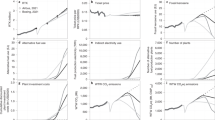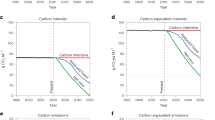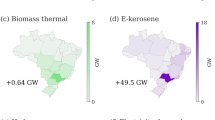Abstract
Decarbonizing aviation requires, among other strategies, use of low-carbon liquid fuels, since electrified propulsion of large aircraft is not yet viable. However, commercialization of such ‘sustainable aviation fuels’ is lagging due to uncertainty about their potential. Here, we integrate land-use assessment, hydroclimate and ecosystem modelling and economic optimization in a systems framework to better characterize the biojet-fuel potential of cellulosic feedstocks. Planting 23.2 Mha of marginal agricultural lands in the United States—roughly the land area of Wyoming—with the grass miscanthus satisfies the country’s projected 2040 jet-fuel demand (30 billion gallons yr−1) at an average cost of US$4.1 gallon−1. Centred in the Midwest region, this marginal land base is a mix of croplands (7.2 Mha) and non-croplands (16 Mha), whose conversion into miscanthus delivers productive biomass, regional cooling without soil moisture loss and the lowest system greenhouse gas emissions (at US$50 tCO2e−1 carbon price). It is unsustainable to source the same quantity of miscanthus biomass through marginal land conversions in the Plains region. Sustainability considerations generate different land conversion patterns than expected from a purely economic vantage point. Integrated approaches, such as used here, are imperative to realistically evaluate the sustainability of bio-based alternative feedstocks.
This is a preview of subscription content, access via your institution
Access options
Access Nature and 54 other Nature Portfolio journals
Get Nature+, our best-value online-access subscription
$29.99 / 30 days
cancel any time
Subscribe to this journal
Receive 12 digital issues and online access to articles
$119.00 per year
only $9.92 per issue
Buy this article
- Purchase on Springer Link
- Instant access to full article PDF
Prices may be subject to local taxes which are calculated during checkout





Similar content being viewed by others
Data availability
A public repository that contains the data underlying the main figures and data needed to obtain the main results is available at https://doi.org/10.7910/DVN/VBFLI2. Additional data that support the findings of this study are available from N.U.A. upon reasonable request. Source data are provided with this paper.
Code availability
All GAMS code needed to replicate our economic optimization results are available at https://doi.org/10.7910/DVN/VBFLI2. Additional code that support the findings of this study are available from N.U.A. upon reasonable request.
References
Davis, S.J. et al. Net-zero emissions energy systems. Science https://doi.org/10.1126/science.aas9793 (2018).
Searchinger, T. et al. Use of US croplands for biofuels increases greenhouse gases through emissions from land-use change. Science 319, 1238–1240 (2008).
Tilman, D. et al. Beneficial biofuels—the food, energy, and environment trilemma. Science 325, 270–271 (2009).
Robertson, G.P. et al. Cellulosic biofuel contributions to a sustainable energy future: choices and outcomes. Science https://doi.org/10.1126/science.aal2324 (2017).
Borrion, A. L., McManus, M. C. & Hammond, G. P. Environmental life cycle assessment of lignocellulosic conversion to ethanol: a review. Renew. Sustain. Energy Rev. 16, 4638–4650 (2012).
Wang, M. Q. et al. Energy and greenhouse gas emission effects of corn and cellulosic ethanol with technology improvements and land use changes. Biomass Bioenergy 35, 1885–1896 (2011).
Wang, M., Han, J., Dunn, J. B., Cai, H. & Elgowainy, A. Well-to-wheels energy use and greenhouse gas emissions of ethanol from corn, sugarcane and cellulosic biomass for US use. Environ. Res. Lett. 7, 045905 (2012).
Field, J. L. et al. Robust paths to net greenhouse gas mitigation and negative emissions via advanced biofuels. Proc. Natl Acad. Sci. USA 117, 21968–21977 (2020).
Scown, C. D. et al. Lifecycle greenhouse gas implications of US national scenarios for cellulosic ethanol production. Environ. Res. Lett. 7, 014011 (2012).
Dwivedi, P. et al. Cost of abating greenhouse gas emissions with cellulosic ethanol. Environ. Sci. Technol. 49, 2512–2522 (2015).
Davis, S. C. et al. Impact of second‐generation biofuel agriculture on greenhouse‐gas emissions in the corn‐growing regions of the US. Front. Ecol. Environ. 10, 69–74 (2012).
Whitaker, J. et al. Consensus, uncertainties and challenges for perennial bioenergy crops and land use. GCB Bioenergy 10, 150–164 (2018).
Field, C. B., Campbell, J. E. & Lobell, D. B. Biomass energy: the scale of the potential resource. Trends Ecol. Evol. 23, 65–72 (2008).
Campbell, J. E., Lobell, D. B., Genova, R. C. & Field, C. B. The global potential of bioenergy on abandoned agriculture lands. Environ. Sci. Technol. 42, 5791–5794 (2008).
Cai, X., Zhang, X. & Wang, D. Land availability for biofuel production. Environ. Sci. Technol. 45, 334–339 (2011).
Zumkehr, A. & Campbell, J. E. Historical US cropland areas and the potential for bioenergy production on abandoned croplands. Environ. Sci. Technol. 47, 3840–3847 (2013).
Dominguez-Faus, R., Powers, S. E., Burken, J. G. & Alvarez, P. J. The water footprint of biofuels: a drink or drive issue. Environ. Sci. Technol. 43, 3005–3010 (2009).
Robertson, G. P., Hamilton, S. K., Del Grosso, S. J. & Parton, W. J. The biogeochemistry of bioenergy landscapes: carbon, nitrogen, and water considerations. Ecol. Appl. 21, 1055–1067 (2011).
VanLoocke, A., Bernacchi, C. J. & Twine, T. E. The impacts of Miscanthus × giganteus production on the Midwest US hydrologic cycle. GCB Bioenergy 2, 180–191 (2010).
VanLoocke, A., Twine, T. E., Zeri, M. & Bernacchi, C. J. A regional comparison of water‐use‐efficiency for miscanthus, switchgrass and maize. Agric. Meteorol. 164, 82–95 (2012).
VanLoocke, A., Twine, T. E., Kucharik, C. J. & Bernacchi, C. J. Assessing the potential to decrease the Gulf of Mexico hypoxic zone with Midwest US perennial cellulosic feedstock production. GCB Bioenergy 9, 858–875 (2017).
Gelfand, I. et al. Sustainable bioenergy production from marginal lands in the US Midwest. Nature 493, 514 (2013).
Georgescu, M., Lobell, D. B. & Field, C. B. Potential impact of US biofuels on regional climate. Geophys. Res. Lett. https://doi.org/10.1029/2009GL040477 (2009).
Georgescu, M., Lobell, D. B. & Field, C. B. Direct climate effects of perennial bioenergy crops in the United States. Proc. Natl Acad. Sci. USA 108, 4307–4312 (2011).
Parker, N. C. et al. Development of a biorefinery optimized biofuel supply curve for the Western United States. Biomass Bioenergy 34, 1597–1607 (2010).
Chen, X., Huang, H. & Khanna, M. Land-use and greenhouse gas implications of biofuels: role of technology and policy. Clim. Change Econ. 3, 1250013 (2012).
Beach, R. H., Zhang, Y. W. & McCarl, B. A. Modeling bioenergy, land use, and GHG emissions with FASOMGHG: model overview and analysis of storage cost implications. Clim. Change Econ. 3, 1250012 (2012).
Clark, C. M. et al. Growing a sustainable biofuels industry: economics, environmental considerations, and the role of the Conservation Reserve Program. Environ. Res. Lett. 8, 025016 (2013).
Murphy, C. W. & Parker, N. C. Impact of air pollution control costs on the cost and spatial arrangement of cellulosic biofuel production in the US. Environ. Sci. Technol. 48, 2157–2164 (2014).
Langholtz, M. H., Stokes, B. J. & and Eaton, L. M. 2016 Billion-Ton Report: Advancing Domestic Resources for a Thriving Bioeconomy (US Department of Energy, 2016).http://energy.gov/eere/bioenergy/2016-billion-ton-report
Hudiburg, T. W. et al. Impacts of a 32-billion-gallon bioenergy landscape on land and fossil fuel use in the US. Nature. Energy 1, 15005 (2016).
Ferin, K. M. et al. Water quality effects of economically viableland use change in the Mississippi River Basin under the renewable fuel standard. Environ. Sci. Technol. 55, 1566–1575 (2021).
Jia, G. et al. in Climate Change and Land: an IPCC Special Report (eds Shukla, P. R. et al.) Ch. 2 (2019).
Seneviratne, S. I. et al. Land radiative management as contributor to regional-scale climate adaptation and mitigation. Nat. Geosci. 11, 88–96 (2018).
Daly, C., Halbleib, M. D., Hannaway, D. B. & Eaton, L. M. Environmental limitation mapping of potential biomass resources across the conterminous United States. GCB Bioenergy 10, 717–734 (2018).
Wang, M. et al. On the long-term hydroclimatic sustainability of perennial bioenergy crop expansion over the United States. J. Clim. 30, 2535–2557 (2017).
Bigelow, D. P. & Borchers, A. Major Uses of Land in the United States (US Department of Agriculture, Economic Research Service, accessed 15 September 2020); https://www.ers.usda.gov/webdocs/publications/84880/eib-178.pdf?v=0
Olmstead, A. L. & Rhode, P. W. Adapting North American wheat production to climatic challenges, 1839–2009. Proc. Natl Acad. Sci. USA 108, 480–485 (2011).
Claassen, R., Carriazo, F., Cooper, J.C., Hellerstein, D. & Ueda K. Grassland to Cropland Conversion in the Northern Plains (USDA Economic Research Service, accessed 31 August 2020); https://www.ers.usda.gov/webdocs/publications/44876/7477_err120.pdf?v=0
Roberts, M. J. & Schlenker, W. Identifying supply and demand elasticities of agricultural commodities: implications for the US ethanol mandate. Am. Econ. Rev. 103, 2265–2295 (2013).
Aragon, N. U. Role of land quality in corn acreage response to price and policy changes: evidence from the Western Corn Belt. Environ. Res. Commun. 1, 061004 (2019).
Huang, E. et al. Multi-objective optimization for sustainable renewable jet fuel production: a case study of corn stover based supply chain system in Midwestern U.S. Renew. Sustain. Energy Rev. 115, 109403 (2019).
Yang, P., Zhao, Q. & Cai, X. M. Machine learning based estimation of land productivity in the contiguous US using biophysical predictors. Environ. Res. Lett. 15, 074013 (2020).
Heaton, E.A. et al. in Advances in Botanical Research (eds Kader, J.-C. & Delseny, M.) Ch. 3 (Academic Press, 2010).https://doi.org/10.1016/B978-0-12-381518-7.00003-0
ICAO Global Framework for Aviation Alternative Fuels. Conversion Processes (ICAO, accessed 24 March 2022); https://www.icao.int/environmental-protection/GFAAF/Pages/Conversion-processes.aspx
Næss, J.S., Cavalett, O. & Cherubini, F. The land–energy–water nexus of global bioenergy potentials from abandoned cropland. Nat. Sustain. 4, 525–536 (2021).https://doi.org/10.1038/s41893-020-00680-5
Miguez‐Macho, G., Fan, Y., Weaver, C. P., Walko, R. & Robock, A. Incorporating water table dynamics in climate modeling: 2. Formulation, validation, and soil moisture simulation. J. Geophys. Res. Atmospheres https://doi.org/10.1029/2006JD008112 (2007).
Powers, J. G. et al. The weather research and forecasting model: overview, system efforts, and future directions. Bull. Am. Meteorol. Soc. 98, 1717–1737 (2017).
Klöwer, M. et al. Quantifying aviation’s contribution to global warming. Environ. Res. Lett. 16, 104027 (2021).
Bock, L. & Burkhardt, U. Contrail cirrus radiative forcing for future air traffic. Atmos. Chem. Phys. 19, 8163–8174 (2019).
Lee, D. S. et al. The contribution of global aviation to anthropogenic climate forcing for 2000 to 2018. Atmos. Environ. 244, 117834 (2021).
9/09/2021: Sustainable Aviation Fuel Grand Challenge Announced (Biomass Research and Development, accessed 20 March 2022); https://biomassboard.gov/sustainable-aviation-fuel-interagency-working-group
2050 ICAO Vision for Sustainable Aviation Fuels (ICAO, accessed 20 March 2022); https://www.icao.int/environmental-protection/GFAAF/pages/ICAO-Vision.aspx
Dahal, K. et al. Techno-economic review of alternative fuels and propulsion systems for the aviation sector. Renew. Sustain. Energy Rev. 151, 111564 (2021).
Rogelj, J. et al. in Special Report on Global Warming of 1.5 °C (eds Masson-Delmotte, V. et al.) Ch. 2 (WMO, 2018). https://www.ipcc.ch/sr15/chapter/chapter-2/
Skamarock W.C. et al. A Description of the Advanced Research WRF Version 3 (NCAR, 2008); https://doi.org/10.5065/D68S4MVH
Chen, F. & Dudhia, J. Coupling an advanced land surface–hydrology model with the Penn State–NCAR MM5 Modeling System. Part I: Model implementation and sensitivity. Mon. Weather Rev. 129, 569–585 (2001).
Ek, M.B. et al. Implementation of Noah land surface model advances in the National Centers for Environmental Prediction operational mesoscale Eta model. J. Geophys. Res. Atmospheres https://doi.org/10.1029/2002JD003296 (2003).
Dohleman, F. G. & Long, S. P. More productive than maize in the Midwest: how does miscanthus do it? Plant Physiol. 150, 2104–2115 (2009).
O’Geen, A. T. et al. Research connects soil hydrology and stream water chemistry in California oak woodlands. Calif. Agric. 64, 78–84 (2010).
Dennehy, K.F., Litke, D.W. & McMahon, P.B. (2002). The High Plains Aquifer, USA: groundwater development and sustainability. Geological Soc. London Special Pub. 193, 99–119 (2002).https://doi.org/10.1144/GSL.SP.2002.193.01.09
Seneviratne, S. I. et al. Investigating soil moisture–climate interactions in a changing climate: a review. Earth Sci. Rev. 99, 125–161 (2010).
Humphrey, V. et al. Sensitivity of atmospheric CO2 growth rate to observed changes in terrestrial water storage. Nature 560, 628–631 (2018).
Green, J. K. et al. Large influence of soil moisture on long-term terrestrial carbon uptake. Nature 565, 476–479 (2019).
Kucharik, C. J. Evaluation of a process-based agro-ecosystem model (Agro-IBIS) across the U.S. cornbelt: simulations of the inter-annual variability in maize yield. Earth Interact. 7, 1–33 (2003).
Twine, T. E. & Kucharik, C. J. Evaluating a terrestrial ecosystem model with satellite information of greenness. J. Geophys. Res. Biogeosci. 113, G03027 (2008).
Miller, D. A. & White, R. A. A conterminous United States multilayer soil characteristics dataset for regional climate and hydrology modeling. Earth Interact. 2, 1–26 (1998).
Parker, N.C. Modeling Future Biofuel Supply Chains using Spatially Explicit Infrastructure Optimization. PhD thesis, Univ. California (2011).
Annual Energy Outlook 2021, Table 2. Energy Consumption by Sector and Source (EIA, accessed 31 January 2022); https://www.eia.gov/outlooks/aeo/tables_ref.php
2016 TIGER/Line County-level Shapefiles (Machine-Readable Data Files) (US Census Bureau, 2016); https://www2.census.gov/geo/tiger/TIGER2016/COUNTY/tl_2016_us_county.zip
Acknowledgements
This study was funded by the National Science Foundation grant EAR-1204774 through the Water Sustainability and Climate initiative. N.U.A. was supported by this grant during her doctoral studies at Arizona State University and later by a gift to the Environmental Defense Fund from the Bezos Earth Fund for her postdoctoral fellowship.
Author information
Authors and Affiliations
Contributions
N.U.A. was responsible for the data collection, preparation of economic model inputs, analysis of results, making of figures, writing and editing. N.C.P. conducted the economic modelling and contributed to the analysis of results, making of figures, writing and editing. W.M. provided synthesis of hydroclimate simulation results. A.V. and J.B. conducted ecosystem modelling. M.G. conceived of the study and contributed to writing and editing. All authors contributed equally to study design and editing of the final manuscript.
Corresponding authors
Ethics declarations
Competing interests
The authors declare no competing interests.
Peer review
Peer review information
Nature Sustainability thanks Mathew Langholtz and the other, anonymous, reviewer(s) for their contribution to the peer review of this work.
Additional information
Publisher’s note Springer Nature remains neutral with regard to jurisdictional claims in published maps and institutional affiliations.
Supplementary information
Supplementary Information
Supplementary Sections 1–7, Figs. 1–10 and Tables 1–8.
Source data
Source Data Fig. 2
The source data for Fig. 2 are not statistical. Data included in these files are aimed at helping readers either reproduce Fig. 2 or access the numerical data underlying the figure.
Source Data Fig. 3
The source data for Fig. 3 are not statistical. Data included in these files are aimed at helping readers either reproduce Fig. 3 or access the numerical data underlying the figure.
Source Data Fig. 4
The source data for Fig. 4 are not statistical. Data included in these files are aimed at helping readers either reproduce Fig. 4 or access the numerical data underlying the figure.
Source Data Fig. 5
The source data for Fig. 5 are not statistical. Data included in these files are aimed at helping readers either reproduce Fig. 5 or access the numerical data underlying the figure.
Rights and permissions
Springer Nature or its licensor (e.g. a society or other partner) holds exclusive rights to this article under a publishing agreement with the author(s) or other rightsholder(s); author self-archiving of the accepted manuscript version of this article is solely governed by the terms of such publishing agreement and applicable law.
About this article
Cite this article
Uludere Aragon, N.Z., Parker, N.C., VanLoocke, A. et al. Sustainable land use and viability of biojet fuels. Nat Sustain 6, 158–168 (2023). https://doi.org/10.1038/s41893-022-00990-w
Received:
Accepted:
Published:
Issue Date:
DOI: https://doi.org/10.1038/s41893-022-00990-w



